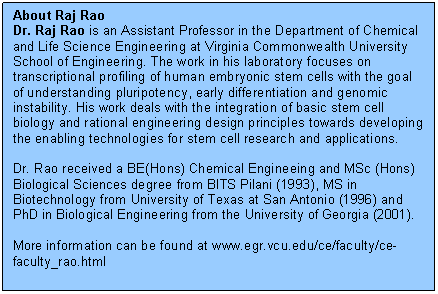Embroynic Stem Cells: Promises and Challenges
By Raj R Rao ('88 Bio-Chem)
The bioengineering of tissues, now called regenerative medicine, is fast emerging as a science and technology with
the potential to revolutionize the future of biomedical therapies. The hope is that specialized cell types can be obtained and used to regenerate specific body parts or organs. One of the critical issues is that of cell source and this is where embryonic stem cells are stepping into the limelight.
 Embryonic stem cells Embryonic stem cells
These are cells that are formed in the first few stages after fertilization, from which develop all of the 220 different cell types that constitute the human body. Stem cells are thus in vitro equivalents of cells found in the developing embryo and have the capacity to divide indefinitely in a laboratory setting. When subjected to specific cues, they are capable of producing different cell types, and this characteristic is classically defined as ‘pluripotency’. In the mouse, these cells have also been shown to produce offspring, experiments that cannot and should not be done in the human for obvious ethical and moral reasons.
The promise of stem cells
Stem cells have gained attention primarily because of their potential applications in the treatment of different chronic diseases and possible transplantation options. For example; one can produce neurons that secrete dopamine for use in Parkinson’s patients. One can also produce specialized islet cells for use in diabetic patients. The diseases that can be treated are thus endless. In addition to their proposed use in cell-based therapy, these cells constitute an excellent in vitro model system for understanding the first steps in development towards the formation of a human being. This model system also serves in understanding, prevention and treatment of birth defects. Additionally, of specific use in the pharmaceutical industry is the potential for these cells and derivatives to constitute cell-based assays in the identification of drug targets and testing of potential therapeutics.
The stem cell wish list
For stem cell researchers, there are some key questions that need to be addressed and these can be considered as a stem cell application wish list. Firstly, depending on the application, it is important to make as many cells of the required type as possible. Issues related to scale-up of manufacturing processes and preservation of biological products needs to be addressed. From a therapy perspective, it is important that many of these survive in an in vivo setting and more importantly not be subject to any rejection due to the host immune system. It is also important that they are stable in culture and in vivo; and once injected into the body, they should continue with the natural differentiation process. From a researcher point of view, it is useful to have a stable funding, ethical and regulatory environment. Lastly and not the least important wish is that they be safe, when used in therapies.
Future of stem cell research
Recent studies have focused on identifying key genes and molecules that define a stem cell. These will help in not only developing methodologies for maintaining stem cells in their nascent state but also in developing directed differentiation strategies for producing specialized cell types. Numerous studies over the past few years have demonstrated the proof of principle of deriving specialized cell types. An often overlooked area of study is the genetic integrity of embryonic stem cells. It is imperative that this issue is addressed as one cannot use cells that are genetically compromised in any therapeutic setting. Our group, along with others recently published data that highlights the need for preserving the genetic integrity of human embryonic stem cell lines. Interdisciplinary approaches between scientists, clinicians and engineers are thus needed to move this fascinating field forward. Technical advances in molecular and cell biology, combined with bioinformatics tools is providing opportunities for greater biological knowledge and understanding of stem cells. Simultaneously, advances in biomaterial and bioreactor technologies will aid in promoting applied engineering approaches to meet the needs of cell expansion, while preserving the biological attributes of the desired product.
Lab Research
The Stem Cell Bioengineering Laboratory is located in the School of Engineering at Virginia Commonwealth University. Research in my lab is at the interface of biology and engineering, with the goal of developing the enabling technologies for stem cell research. Systems biology approaches are being used to characterize and evaluate stem cells, so that we can develop appropriate step-wise processes for differentiation. Additionally, we work on engineering micro-environments to maintain stem cells or to differentiate them into specialized cell types.
|

